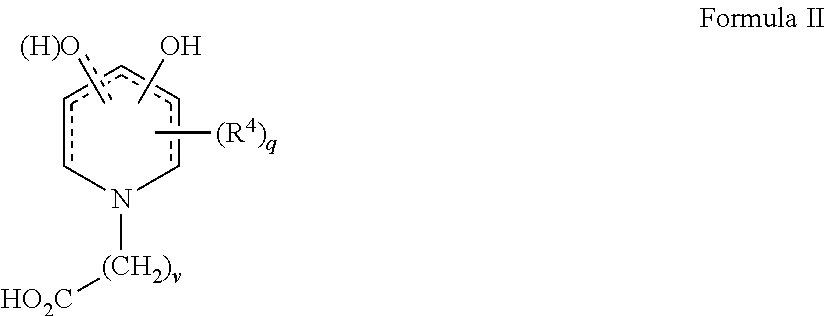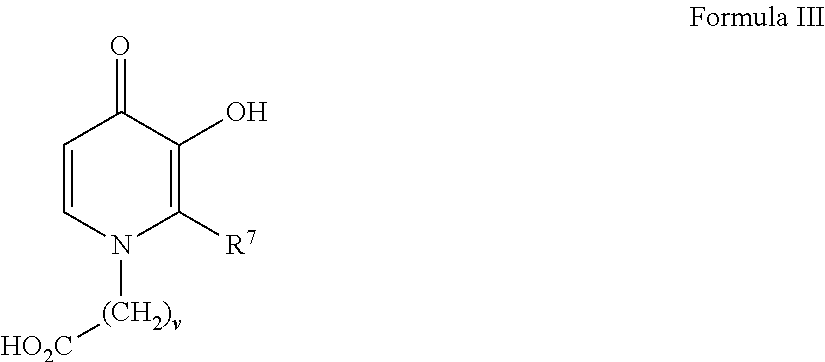Compositions comprising carbon dioxide and reverse micelles and methods of use
- Summary
- Abstract
- Description
- Claims
- Application Information
AI Technical Summary
Benefits of technology
Problems solved by technology
Method used
Image
Examples
example 1
Preparation of 1-(11′-carboxydecyl)-3-hydroxy-2-methyl-4-pyridinone and Related Analogs
[0096]1-(11′-Carboxydecyl)-3-hydroxy-2-methyl-4-pyridinone was prepared by hydrogenating 3-benzyloxyl-1-11′-carboxydecyl-2-methyl-4-pyridinone, itself prepared according to routine synthetic methods that are known to the skilled artisan. For example, 0.24 g of the 3-benzyloxy precursor was combined in a Parr hydrogenation apparatus with 50 mL of 95% ethanol and 99 mg Pd / C. Following evacuation of the air within the apparatus, hydrogen gas was added at approximately 18 PSI and the mixture was shaken shaking at room temperature for 20 hours, filtered and the filtrate was concentrated and recrystallized from ethanol to yield 0.087 g of 1-(11′-carboxydecyl)-3-hydroxy-2-methyl-4-pyridinone having a melting range of 168-170° C.
[0097]Related analogs such as those shown in the table below were made from known reactions including the hydrogenation of a benzyl-protected precursors as described above.
TABLE 1...
example 2
Preparation of Reverse Micelles in Decalin as a Model for Hydrophobic Solvents Such as Crude Oil
[0098]Reverse micelles were prepared in decalin (decahydronaphthalene, cis and trans isomers) comprising cocamide diethanolamine (DEA) and a 26.7 wt % solution (having a molar ratio of 1:37) of Fe(NO3)3 in water.
[0099]Four series of mixtures, each with a common concentration of cocamide DEA but with different amounts of Fe3+ were prepared. The four concentrations of cocamide DEA were 0.08, 0.16, 0.24, and 0.32 M. First, a specified amount of cocamide DEA was added to decalin. The mixture was gently shaken to obtain a uniform, clear solution. The solution was slightly yellow. Then, a specified amount of the Fe(NO3)3 solution was added, and the mixture was gently shaken. The mixture was left to stand. Some of the mixtures separated into two or three phases. It typically took a day or two for the mixture to reach the equilibrium volume ratio of the multi-phases. The table below summarizes ob...
example 3
Preparation of Cocamide DEA-Based Micelles Comprising Carbon Dioxide
[0105]Cocamide DEA was dissolved in 0.1M MOPS Buffer, pH 7.4, and another solution of freshly prepared Iron (III) ammonium sulfate was added to give a threefold molar excess of Fe3+ ion. Then, a change in the color of the solution was noted (clear to red-brown), and confirmed by UV-visible spectroscopy. When carbonated water (seltzer) containing approximately a stoichiometric amount of carbon dioxide was added to the surfactant—Iron (III) solution, almost immediately the solution became highly viscous. Control samples containing MOPS buffer alone or samples of two other types of surfactants (sodium dodecyl sulfate or Triton X-100), when tested separately, did not show a color change or an increase in the viscosity.
PUM
 Login to View More
Login to View More Abstract
Description
Claims
Application Information
 Login to View More
Login to View More - R&D
- Intellectual Property
- Life Sciences
- Materials
- Tech Scout
- Unparalleled Data Quality
- Higher Quality Content
- 60% Fewer Hallucinations
Browse by: Latest US Patents, China's latest patents, Technical Efficacy Thesaurus, Application Domain, Technology Topic, Popular Technical Reports.
© 2025 PatSnap. All rights reserved.Legal|Privacy policy|Modern Slavery Act Transparency Statement|Sitemap|About US| Contact US: help@patsnap.com



